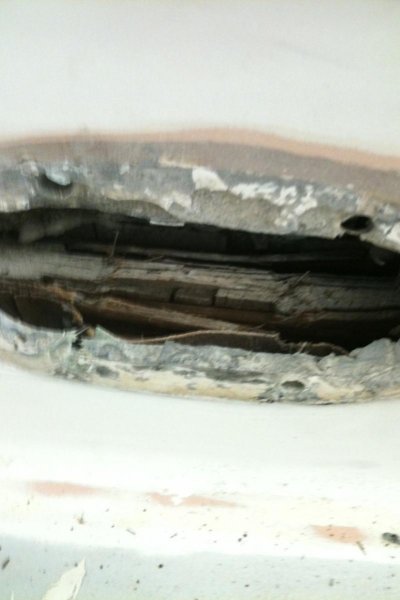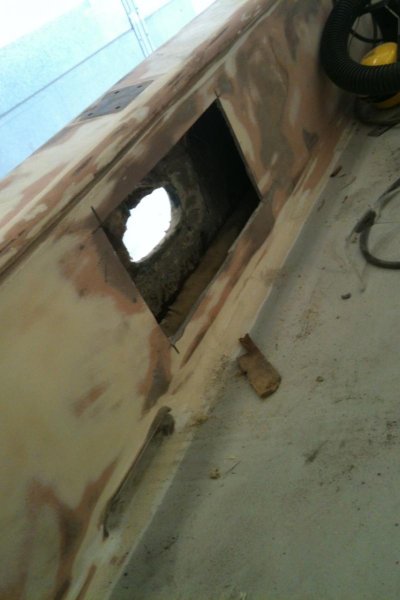JanisK
Veteran Member
- Joined
- Aug 8, 2011
- Messages
- 88
- Location
- Australia
- Vessel Name
- NightinGayle
- Vessel Make
- Tradewinds 42
Gemma is currently undergoing a hull and topsides repaint as the old topcoat was badly flaking and peeling due to weathering and poor preparation prior to painting by a PO.
During this exercise (which shall be the subject of a later post) a number of unknown unknowns have emerged. For this particular one I would like some help please.
The Hawse brass cleats and fairleads have over time become quite loose allowing movement when under tension by a berth line or snubber thus allowing water to enter into the area between the hull fibreglass and the inside bulwark. The timber ply support between the hull and bulwark has completely delaminated and broken apart and has to be removed and replaced.
Since the cleats and thus the immediate surrounding areas of the bulwark endure a lot of tension, pressure and jerking as berth lines or snubbers take up tension I am told these are very important reinforcements and supports to eliminate flex in the bulwark.
Problem is after removal of the cleats and fairlead the hawsehole is very small relative to the size of the new ply supports to be inserted and are nigh on impossible to fit so that they provide effective support.
The shipwrights at the slipyard are telling me the best way to replace these supports would be to cut out an area of fibreglass from the bulwark that is greater in diameter than the hawsehole, insert and epoxy the timber sorts, the re glass the bit of the bulwark that was cut out and then do some cosmetic filling prior to repaint.
This seems rather extreme to me as it will need be done for all six hawseholes.
So the questions are:
Has anyone ever done this and is there a better way?
Also how important are these timber supports anyway as the ones being removed (or what is left of them) do not appear to have been the full thickness of the inside cavity between bulwark and hull and could not have been much use anyway?
What do current boatbuilders of Clippers and even Bayliner do to reinforce the hawseholes?
Thanks in advance for your help.
During this exercise (which shall be the subject of a later post) a number of unknown unknowns have emerged. For this particular one I would like some help please.
The Hawse brass cleats and fairleads have over time become quite loose allowing movement when under tension by a berth line or snubber thus allowing water to enter into the area between the hull fibreglass and the inside bulwark. The timber ply support between the hull and bulwark has completely delaminated and broken apart and has to be removed and replaced.
Since the cleats and thus the immediate surrounding areas of the bulwark endure a lot of tension, pressure and jerking as berth lines or snubbers take up tension I am told these are very important reinforcements and supports to eliminate flex in the bulwark.
Problem is after removal of the cleats and fairlead the hawsehole is very small relative to the size of the new ply supports to be inserted and are nigh on impossible to fit so that they provide effective support.
The shipwrights at the slipyard are telling me the best way to replace these supports would be to cut out an area of fibreglass from the bulwark that is greater in diameter than the hawsehole, insert and epoxy the timber sorts, the re glass the bit of the bulwark that was cut out and then do some cosmetic filling prior to repaint.
This seems rather extreme to me as it will need be done for all six hawseholes.
So the questions are:
Has anyone ever done this and is there a better way?
Also how important are these timber supports anyway as the ones being removed (or what is left of them) do not appear to have been the full thickness of the inside cavity between bulwark and hull and could not have been much use anyway?
What do current boatbuilders of Clippers and even Bayliner do to reinforce the hawseholes?
Thanks in advance for your help.




